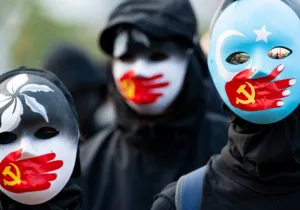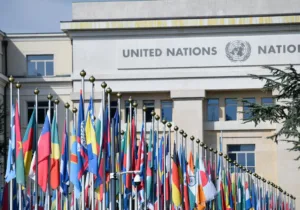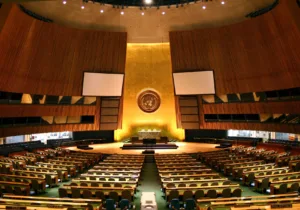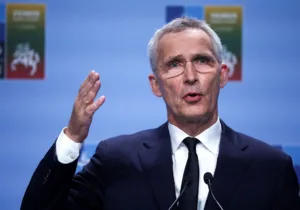Citing “tremendous anger and open hostility” from Pyongyang—in recent days, the North Korean regime called our vice president “a political dummy” and warned the president that he must “meet us in a meeting room or encounter us at a nuclear-to-nuclear showdown”—President Donald Trump last week canceled what would have been a historic summit between the United States and North Korea in Singapore. But now, it appears there are talks underway to rescue the talks, with Secretary of State Mike Pompeo scheduled to meet a high-level aide to North Korean dictator Kim Jong-un and with the White House announcing that it “continues to actively prepare” for the Singapore Summit—just the latest example of Trump’s chaos theory of foreign policy. If or when Trump and Kim finally meet, the president should put human rights on the table. Promoting America’s highest ideals is always in America’s national interests.
Trump may need to be reminded of this. After all, the president and key administration figures have tended to downplay human rights and instead focus on interests. Before his election, for example, Trump declared, “If we are going to intervene in a conflict, it had better pose a direct threat to our interest.” In addition, he was blunt and unfeeling about the carnage in Syria: “Why do we care?” he asked as a candidate.
Trump’s National Security Strategy commits the administration to “a clear-eyed assessment of US interests” and “a strategy of principled realism.”
In that vein, then-Secretary of State Rex Tillerson explained in 2017, “If we condition too heavily that others must adopt this value that we’ve come to over a long history of our own, it really creates obstacles to our ability to advance our national security interests, our economic interests.”
However, when Trump launched punitive strikes in response to Assad’s chemical attacks, the president used the language of humanitarian intervention, describing the deaths of “innocent children” as “an affront to humanity.” Likewise, Trump’s State of the Union address described Kim’s regime as “cruel” and “depraved,” adding that Pyongyang “has oppressed its own citizens” “brutally.” In that same speech, Trump shared the story of Ji Seong-ho, “a starving boy in North Korea” who was tortured after admitting he associated with Christians, fled the North, and lost his father to Kim’s vast torture chamber.
This is not the language of Nixonian realism. In fact, it sounds a lot like the language President Ronald Reagan used in dealing with Moscow, which brings us back to the on-again-off-again summit.
The pragmatic, realpolitik approach to a Trump-Kim summit says America should downplay human rights and negotiate the best deal for US security interests: unfettered inspections to ensure North Korea has given up its nuclear arsenal. In exchange, Pyongyang would want a no-invasion pledge, a peace treaty to replace the 1953 armistice, a lifting of sanctions, and removal from the US terror-states list. Those are doable. US withdrawal from the peninsula, however, is a nonstarter. Reagan and the elder Bush, after all, didn’t pull out of Europe as they negotiated an end to the Cold War with a much more rational and balanced adversary in Mikhail Gorbachev.
Another approach says Trump should hammer Kim on human rights, publicly demand that if Pyongyang wants America to stop treating it like a rogue regime it must start treating its people like people, and browbeat Kim about free speech, religious liberty, and freedom of movement.
If any regime needs to be lectured about human rights, it’s the Kim Dynasty. A United Nations panel has unearthed “a wide array of crimes against humanity” and “unspeakable atrocities” in North Korea: “persecution on political, religious, racial and gender grounds, the forcible transfer of populations, the enforced disappearance of persons…prolonged starvation…extermination, murder, enslavement, torture, imprisonment.”
But public shaming won’t do any good; after all, the shameless cannot be shamed.
Seeds
Still, interests and ideals need not be segregated into separate agendas, as Reagan’s handling of the Soviet Union reminds us.
By the early 1970s, the Soviets desperately wanted the West to recognize and, in effect, bless the postwar landscape in Europe. Western leaders used this as leverage to force Moscow to begin discussing—if not observing—human rights.
The result was a three-year process that culminated in 1975 with the Helsinki Accords. Moscow got the Western powers to recognize (officially) something they had drudgingly observed since the end of World War II: “the inviolability of frontiers” and “territorial integrity of states” in Europe. In exchange, the West extracted from Moscow a promise to “respect…human rights and fundamental freedoms, including the freedom of thought, conscience, religion or belief.”
It was just that—a promise—and many argued at the time that the Kremlin gave up nothing in the deal. To be sure, Helsinki served to validate Soviet control over Eastern Europe—of course, tens of thousands of Soviet-bloc tanks and nuclear warheads did far more to ensure Soviet domination of Eastern Europe than a piece of paper—but the Helsinki Accords didn’t just confer de jure approval onto the de facto status of postwar Europe. Helsinki sowed the seeds for the democratic revolutions that toppled communism in Eastern Europe just over a decade later.
A little-known Polish cardinal named Karol Wojtyla “was of two minds” about Helsinki, as John O’Sullivan writes, “disliking its confirmation of Yalta but also grasping how dissidents might exploit its provisions on rights.” The future pope “saw its liberating potential,” according to O’Sullivan. Indeed, dissidents in Poland, Czechoslovakia, and Hungary began to point to the accords as evidence of the falsity, brokenness, and corruptness of the communist system.
Ultimately, even critics of the Helsinki process—critics like Reagan—would use it against Moscow. Reagan privately called on Soviet leader Leonid Brezhnev to “permit the restoration of basic human rights in Poland provided for in the Helsinki Final Act.” In one of his first letters to Gorbachev, Reagan wrote, “We believe strongly that strict observance of the Universal Declaration of Human Rights and of the Helsinki Final Act is an important element of our bilateral relationship.” Months later, Reagan added, “We’ve got to make them see that the full human rights, the rights they agreed to in the Helsinki pact, have got to be observed.”
To be sure, Reagan pushed Moscow to respect human rights partly because it was a propaganda win for the West. Although the West is imperfect, rooted within it is a mechanism for self-criticism and reform, which forces Western governments to address their flaws and failures. The Soviet system had no such mechanism, and because there was nothing above the atheist Soviet state, it could justify any excess, any brutality against humanity and the individual. After decades of excesses and brutalities, it was easy for Reagan to point out Moscow’s industrial-scale assault on human rights.
But there was another reason Reagan pressed the human rights issue with Moscow. Unlike the trade über alles caucus in Congress or the words-over-action Obama administration or the interests-over-values Trump administration, Reagan believed that “promotion of human rights represents a central tenet of our foreign policy,” that “our view of human rights derives from our Judeo-Christian heritage and the view that each individual life is sacred,” that “there is no true international security without respect for human rights.”
Reagan’s example reminds us that the president can promote both America’s interests and its ideals. Reagan negotiated sweeping arms agreements with Moscow that brought about an end to the Cold War, but he also relentlessly and repeatedly defended human rights. He emphasized the Soviet regime’s persecution of Christians and its refusal to allow hundreds of thousands of Jews to emigrate for religious reasons. Gorbachev tried to limit discussions to arms control, but Reagan, in his own words, “led off” summit meetings by raising human rights. “Did it ever occur to you,” Reagan asked Gorbachev privately but forcefully, “that maybe if these Jews were permitted to worship as they want to and to teach their children the Hebrew language…maybe they wouldn’t want to leave the Soviet Union?” And Reagan promoted human rights from the bully pulpit, arguing, “A little less détente with the Politburo and more encouragement to the dissenters might be worth a lot of armored divisions.”
We’re obviously a long way from the Reagan-Gorbachev summits of 1985–88. For that matter, we may still be a long way from having a summit. Moreover, Kim is no Gorbachev, and Trump is no Reagan. But at least the two sides are talking. Even Trump’s letter canceling the summit—which mentioned the possibility of “lasting peace” on the peninsula and described Kim’s release of American hostages as “a beautiful gesture”—is evidence that Pyongyang and Washington are communicating. If the two sides are communicating, then Washington should spend some time communicating about human rights.
Kim has already gotten a “win” by getting an American president to agree to meet him. Trump has gotten a win by making Kim blink—and making his many critics in DC and on TV scratch their heads. If the two can make it to Singapore and then leave with the framework for a deal, that would be another win for both. If Trump can somehow cajole or charm Kim into beginning a process that would allow the North Korean people to be treated like people, that would be a win for humanity.
—
Alan Dowd is a contributing editor to Providence and a senior fellow with the Sagamore Institute Center for America’s Purpose.
Photo Credit: Kim Jong-un meets Secretary of State Mike Pompeo. Released on May 9, 2018, by North Korea’s Korean Central News Agency (KCNA).







 Sponsor a student for Christianity & National Security 2024
Sponsor a student for Christianity & National Security 2024